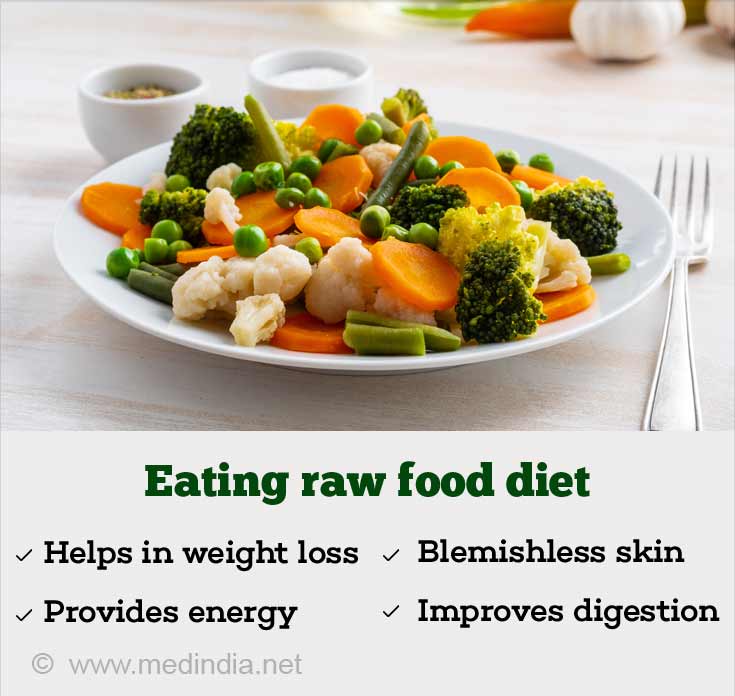- Details & Benefits of a High Raw Diet - (http://www.kristensraw.com/why_raw_details
_benefits.php) - Vegetarian and Vegan Diets Explained - (http://www.webmd.com/food-recipes/tc/vegetarian-diets-what-is-a-vegetarian)
What is a Raw Food Diet?
Raw food diet consists of uncooked and unprocessed food items that have not been heated above 46 degree Celsius. This new trend is catching popularity day by day in the world of health, diet and weight loss. Supporters of raw food diet claim that the benefits of eating raw food diet include weight loss, ample amount of energy every day, a fit mind and body, clear skin, improved digestion and overall health.
“Nothing will benefit human health and increase the chances of survival of life on Earth as much as the evolution to a vegetarian diet”- Albert Einstein
People who follow raw food diet believe that cooking or heating denatures the enzymes and nutrient value of the food. For example, sulfonamides, cancer-fighting compounds in broccoli are greatly reduced when they are cooked. Vitamin C and folate in food are also destroyed by heat. Cooking also promotes the formation of harmful compounds in food during cooking, such as heterocyclic amines. However, there are certain food items, like tomatoes, whose nutrients are increased when cooked.
Types of Raw Food Diet:
Raw Vegans: Vegans are those people who exclude meat, eggs, milk and other animal-derived ingredients. Many vegans avoid refined white sugar, processed with animal charcoal and wine. Some people can go to extremes avoiding animal-derived non-food products, such as leather, fur and wool.
A raw vegan diet contains unprocessed, raw plant foods that have not been cooked or heated above 40 degree Celsius. There are several ways to make such vegan food. Some of the ways are mentioned below:
- Soaking and Sprouting: Enzyme inhibitors present in beans, legumes and nuts destroy the digestive enzymes present in our body. Soaking and germination or sprouting help remove these enzyme inhibitors thus, making the nuts nutritious.
- Dehydrating: Food items can be heated at 20 degree Celsius or below using a dehydrator, which stimulates sun drying. Sun-dried tomatoes, kale chips, crackers, breads, and fruit leathers are a few examples of dehydrated vegan food. Dehydrated food items can be preserved for a longer time.
- Blending: Fruits and vegetables are blended for making recipes like smoothies, soups, hummus. Blending helps to mix a variety of fruits and vegetables to enhance the nutrient value and taste of the food.
- Juicing: Juicing is the process of taking out juices from fruits and leafy vegetables. For instance, juice of fresh coriander leaves mixed with dried spices and oils is the best source of antioxidant and is an antidote for the harm caused to the body due to smoking cigarettes.
Raw Vegetarianism:
Vegetarianism is the practice of eating only fruits and vegetables and abstaining from animal food products such as meat, fish and poultry but includes dairy and eggs. Common food items are vegetables, sprouts, nuts, grains, legumes, dairy, eggs and honey that are included in this diet.
There are several kinds of vegetarianism:
- Lacto-Ovo Vegetarians: 'Lacto' stands for milk and 'Ovo' stands for egg. Lacto-ovo vegetarians are those who eat egg and milk and its products such as cheese, butter and yogurt but they abstain from meat, poultry, seafood and fish.
- Lacto-Vegetarians: Lacto-vegetarians consume milk products, but they exclude eggs, meat, poultry, seafood and fish.
- Vegans: Vegans are those people who are complete vegetarians. They eat only plant foods and avoid food items that come from animals in any way.
Raw Animal Food Diets:
Raw animal food diets are followed by those people who eat uncooked animal products, such as raw muscle-meats, raw organs, eggs, fermented meat and fish and dairy products such as non-pasteurized milk and derivatives made out of it such as cheese and butter. The Primal diet and Paleolithic diet are examples of a raw meat diet. The Primal diet consists of fatty meats, organ meats like kidney, liver and brain, dairy, honey, minimal fruit and vegetable juices and coconut cream, all in raw condition. The Paleolithic diet consists of raw eggs, raw plant foods, raw seafoods, raw meats and raw organs to name a few.
Benefits of Raw Food Diet:

- Eating raw food gives a person a higher amount of energy and the person feels less tired and lazy.
- It keeps your body hydrated, as raw foods require minimal body fluids for digestion.
- Raw food diet helps people to lose weight more easily and efficiently.
- It is evident that a cooked bean does not grow but a raw one does. This shows that all the vital nutrients are present undestroyed in raw food that benefits our health.
- Raw food items that are rich in fiber naturally clean our clogged bowels and keep our body free of toxins.
Disadvantages of Raw Food Diet:
- The fruits, vegetables and meat if not washed and cooked well can let some parasites like tapeworm and liver fluke inside the body. This leads to food poisoning.
- Raw meat and eggs are not easy to digest and cause indigestion.
- Studies from the Archives of Internal Medicine state that raw food diet causes low bone density and associated risks.
- Several studies published by the American Journal of Clinical Nutrition show that vegans who just depend on raw fruits and vegetables are prone to vitamin-B12 deficiency, which is important for blood cell production and healthy functioning of the brain.
- Vegans who avoid milk and milk products have higher risks of deficiency of vitamin D if they are not taking any supplements.
Hence, it is suggested that a balanced diet should contain portions of every kind of food, both cooked and uncooked.







